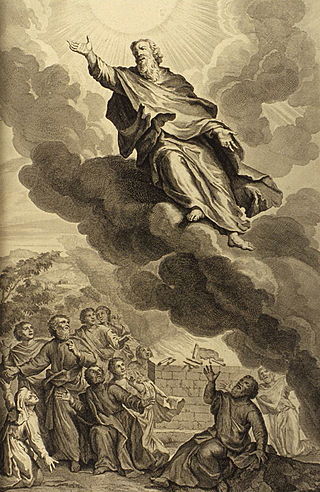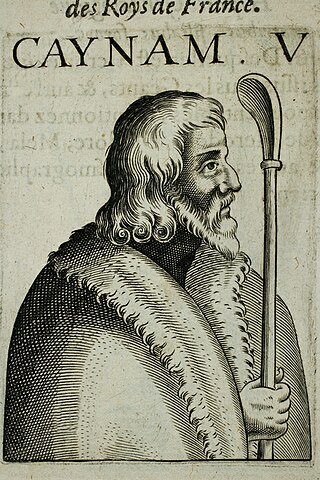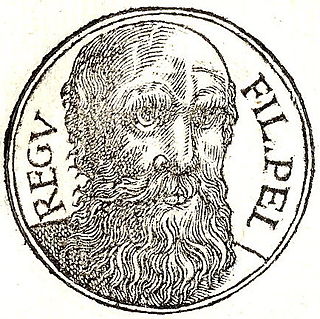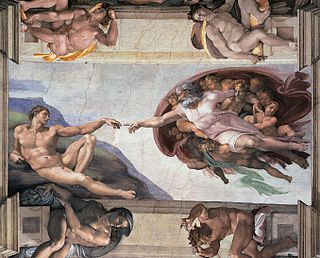
Benjamin was the last of the two sons of Jacob and Rachel in Jewish, Christian and Islamic tradition. He was also the progenitor of the Israelite Tribe of Benjamin. Unlike Rachel's first son, Joseph, Benjamin was born in Canaan according to biblical narrative.
The Book of Genesis is the first book of the Hebrew Bible and the Christian Old Testament. Its Hebrew name is the same as its first word, Bereshit. Genesis is an account of the creation of the world, the early history of humanity, and of Israel's ancestors and the origins of the Jewish people.

Methuselah was a biblical patriarch and a figure in Judaism, Christianity, and Islam. He had the longest lifespan of all those given in the Bible, having died at the age of 969. According to the Book of Genesis, Methuselah was the son of Enoch, the father of Lamech, and the grandfather of Noah. Elsewhere in the Bible, Methuselah is mentioned in genealogies in 1 Chronicles, Genesis, and the Gospel of Luke.

The Samaritan Torah, commonly called the Samaritan Pentateuch, is a text of the Torah written in the Samaritan script and used as sacred scripture by the Samaritans. It dates back to one of the ancient versions of the Hebrew Bible that existed during the Second Temple period, and constitutes the entire biblical canon in Samaritanism.

Enoch is a biblical figure and patriarch prior to Noah's flood, and the son of Jared and father of Methuselah. He was of the Antediluvian period in the Hebrew Bible.

The Book of Jubilees, sometimes called Lesser Genesis (Leptogenesis), is an ancient Jewish religious work of 50 chapters, considered canonical by the Ethiopian Orthodox Church as well as Beta Israel, where it is known as the Book of Division. Jubilees is considered one of the pseudepigrapha by Roman Catholic, Eastern Orthodox, and Protestant Churches. It is also not considered canonical within Judaism outside of Beta Israel.

Peleg is mentioned in the Hebrew Bible as one of the two sons of Eber, an ancestor of the Ishmaelites and the Israelites, according to the Generations of Noah in Genesis 10–11 and 1 Chronicles 1.

The Nephilim are mysterious beings or people in the Hebrew Bible who are described as being large and strong. The Hebrew word Nephilim is sometimes translated as "giants", and sometimes taken to mean "the fallen ones". Their origins are disputed. Some view them as offspring of fallen angels and humans. Others view them as offspring of the descendants of Seth and Cain.

The patriarchs of the Bible, when narrowly defined, are Abraham, his son Isaac, and Isaac's son Jacob, also named Israel, the ancestor of the Israelites. These three figures are referred to collectively as "the patriarchs", and the period in which they lived is known as the patriarchal age.

Kenan is an Antediluvian patriarch first mentioned in the Book of Genesis in the Hebrew Bible.
The genealogies of Genesis provide the framework around which the Book of Genesis is structured. Beginning with Adam, genealogical material in Genesis 4, 5, 10, 11, 22, 25, 29–30, 35–36, and 46 moves the narrative forward from the creation to the beginnings of the Israelites' existence as a people.

The Jahwist, or Yahwist, often abbreviated J, is one of the most widely recognized sources of the Pentateuch (Torah), together with the Deuteronomist, the Priestly source and the Elohist. The existence of the Jahwist is somewhat controversial, with a number of scholars, especially in Europe, denying that it ever existed as a coherent independent document. Nevertheless, many scholars do assume its existence. The Jahwist is so named because of its characteristic use of the term Yahweh for God.

Reu or Ragau, according to Genesis in the Hebrew Bible, was the son of Peleg and the father of Serug, thus being Abraham's great-great-grandfather and the ancestor of the Israelites and Ishmaelites.

Serug was the son of Reu and the father of Nahor, according to Genesis 11:20–23. He is also the great-grandfather of Abraham, thus the ancestor of the Ishmaelites and the Israelites.

According to the Torah, Kehath or Kohath was one of the sons of Levi and the patriarchal founder of the Kehathites, one of the four main divisions of the Levites in biblical times. In some apocryphal texts, such as the Testament of Levi and the Book of Jubilees, Levi's wife, Kehath's mother, is Milkah, a daughter of Aram.
"Generations of Adam" is a genealogical concept recorded in Genesis 5:1 in the Hebrew Bible. It is typically taken as the name of Adam's line of descent going through Seth. Another view equates the generations of Adam with material about a second line of descent starting with Cain in Genesis 4, while Genesis 5 is taken as the "generations of Noah".

The chronology of the Bible is an elaborate system of lifespans, 'generations', and other means by which the Masoretic Hebrew Bible measures the passage of events from the creation to around 164 BCE. It was theological in intent, not historical in the modern sense, and functions as an implied prophecy whose key lies in the identification of the final event. The passage of time is measured initially by adding the ages of the Patriarchs at the birth of their firstborn sons, later through express statements, and later still by the synchronised reigns of the kings of Israel and Judah.

Lamech was a patriarch in the genealogies of Adam in the Book of Genesis. He is part of the genealogy of Jesus in Luke 3:36.

Selah, Salah or Sala or Shelah is an ancestor of the Israelites and Ishmaelites according to the Table of Nations in Genesis 10. He is thus one of the table's "seventy names". He is also mentioned in Genesis 11:12–15, 1 Chronicles 1:18–24, and Luke 3:35–36.

The primeval history is the name given by biblical scholars to the first eleven chapters of the Book of Genesis in the Hebrew Bible. These chapters convey the story of the first years of the world's existence.

















